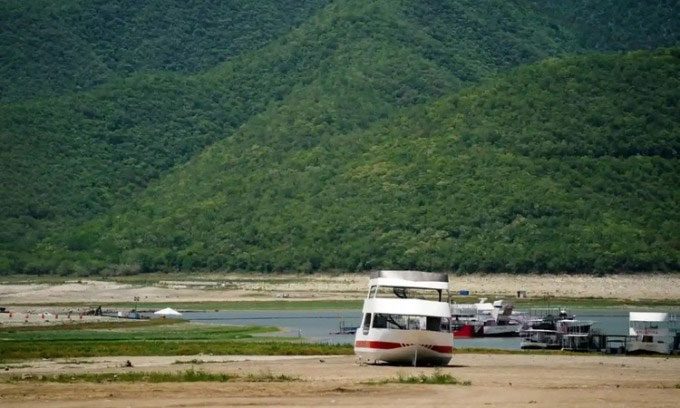The Mexican government has announced a 98% success rate for its artificial rain project, but experts are calling on authorities to improve the water supply and irrigation systems.
The government of Mexico is undertaking the latest phase of its artificial rain project in hopes of increasing rainfall during a historic heatwave and several months of drought, as reported by Guardian on July 23. The project, which began in July, involves deploying aircraft into clouds to release silver iodide particles, thereby creating additional water droplets and increasing rainfall.

A boat stranded in the Boca water reservoir in Santiago, Mexico due to drought. (Photo: Fernando Llano/AP)
Artificial rain aims to “combat the effects of drought in rural areas and contribute to replenishing the aquifer”, according to Mexico’s Ministry of Agriculture, which has implemented this measure at least once a year since 2020. The government claims significant success, stating that the project has a 98% effectiveness rate and even helped extinguish wildfires in 2021.
However, leading cloud physicists in Mexico have expressed concerns about the feasibility of the technology. “There is no technical evidence that artificial rain increases precipitation in crucial economic areas, and we cannot be sure of the impact outside the targeted region,” said Fernando García García and Guillermo Montero Martínez, two cloud physicists from the National Autonomous University of Mexico (Unam).
While the Mexican government asserts that the artificial rain activities in 2021 resulted in a 40% increase in rainfall compared to forecasts, scientists argue that rainfall predictions are highly variable and the evidence does not conclusively link artificial rain to increases in precipitation. They monitored the world’s longest artificial rain study from 1948 to 1970 and could not draw convincing conclusions. According to researchers, artificial rain should only be considered as one component in an integrated water resource management strategy.
Farmers in northern Mexico are experiencing severe drought. This month is the hottest on record in Mexico, with temperatures exceeding the average by 2.3 degrees Celsius. The heat has killed livestock, driving up pork and beef prices in many areas across the country. Firefly populations in wet forests have also dried up, affecting tourism. At the border between the United States and Mexico in Mexicali, temperatures reached 50.2 degrees Celsius, setting a national record. At least 167 Mexicans have died due to the heat. June 2023 was the driest June since 1941, with rainfall 60% below average.
In both rural and urban areas, Mexico is not adequately prepared for extreme climate events, according to Luyando, a professor of climate change and solar radiation at Unam. Urban areas are becoming heat islands, while rural areas are increasingly transforming into desolate deserts.


















































